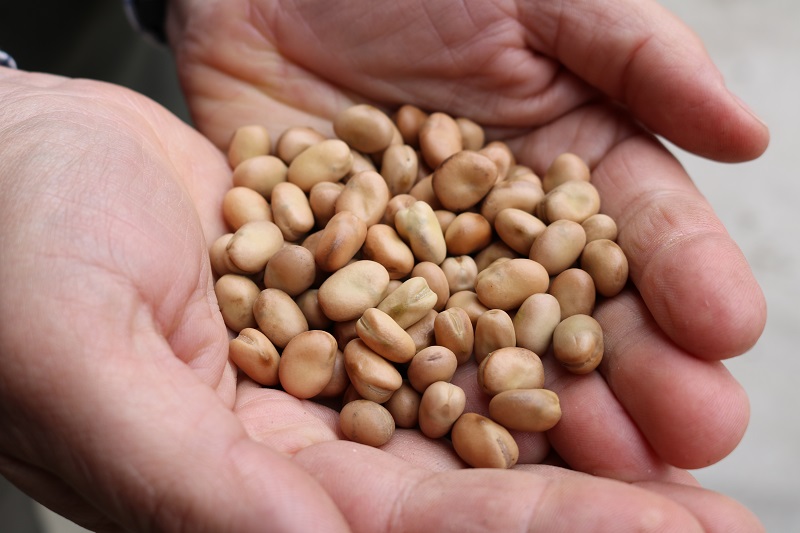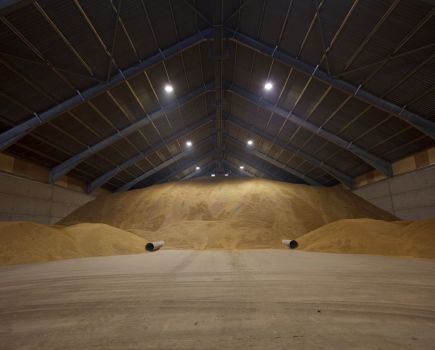Despite the current market downturn, spring beans are still a profitable crop if grown well. CPM visits a Leics grower to find out how.
The key consideration with beans is not to treat them as a second crop.
By Tom Allen-Stevens
It’s a fairly dank morning in June, and despite some bean weevil damage, Mark Wells’ Vertigo spring beans hold plenty of promise for a decent crop.
The finances may tell a different story, however. Burbage Farms near Leicester has grown a pulse crop for many years and achieved a consistently good result. But last year, the spring beans gross margin fell to less than half the bonanza return achieved in 2014, and 40% down on the farm’s five-year average (see chart on page xx).
So is this a crop that’s beginning to lose its appeal? Mark Wells doesn’t think so. “The bean price is down only because everything else has fallen in value, and the returns have been very consistent, before last year. Grown well, beans still bring a decent return, and for all the other benefits they have, they’re well worth keeping in the rotation.”
Farming with his brother Keith and father John, Mark Wells grows mainly seed crops across the 800ha of predominantly medium loams, that range from heavy to light soils, often within the same field. The herbage seed enterprise takes around 20% of the cropped area, and dictates the workload for much of the rotation that falls in around it.
“We aim for as many first wheats as we can – we don’t get on well with second wheat as we tend to suffer take-all. Ideally, we don’t grow oilseed rape more than once in four years, so what else does that leave you with?”
The farm has tried linseed, which has proven difficult to harvest, and even poppies, which rely heavily on contract operations. “We used to grow peas, which often go flat, making them hard to harvest. But spring beans are a crop that fits in well.”
Consistent yield
They’ve also yielded consistently well, he points out, with a five-year average above 6t/ha, and rarely slipping below 5t/ha. But that’s not left to chance, he insists. “The key consideration with beans is not to treat them as a second crop. They deserve as much attention as OSR and wheat, and are capable of bringing a good financial return.”

The farm’s 2015 crop of Vertigo won best spring bean sample in the British Edible Pea Association awards.
Indeed, the farm’s 2015 crop of Vertigo won best spring bean sample in the British Edible Pea Association awards, and you get the impression it was the product of a methodical and well rehearsed growing regime. One aspect you notice in particular is a lack of blackgrass on the farm, despite an over-the-hedge spot survey suggesting it’s a grassweed that thrives in the area.
“It’s like having an army parked on the border all around us,” notes Mark Wells. “We’re in a war, and it’s a constant battle to keep blackgrass to a rogueable level.”

Pulse of profitability – how spring beans stack up
But he doesn’t consider spring beans as a failsafe ally in this battle. “The problem with beans is that it’s an open crop, and you can miss late-germinating blackgrass that will hide beneath the canopy and go to seed unnoticed – you think you’re clear, but there’ll be a patch. The best strategy is to map your blackgrass and monitor that area – beans at least offer you the chance to tackle the weed outside a cereal crop.”
The beans follow wheat in the rotation. While a 3m Sumo Trio prepares the land in front of wheat and OSR, there are two Kverneland ploughs used in front of the beans and either side of the herbage seed. “We’ll plough the heavier land in the late autumn to get as much frost mould as we can. On lighter soils, we have over-wintered stubbles as part of Higher-Level Stewardship, so these are ploughed as soon as we’re allowed in Feb.
“We’ve had success without ploughing – in 2012, we took the Trio through and it gave us a decent seedbed to work with. You need a kind spring, though, as it can tend to leave the land wetter than the plough.”
On lighter soils, a spring-tined cultivator passes in front of the 4m Väderstad Rapid drill, while a 5m Weaving Frandent power harrow pulls the seedbed into shape on heavier land.
“We aim for a drilling date of 5-15 March, but it’s best to be guided by soil temperature. Establishment is critical for beans – they won’t root well in compacted ground and don’t like cold, wet soils. So it’s always worth delaying until conditions are right and keeping spring cultivations to a minimum,” notes Mark Wells. Fields are left to dry off for two days and then rolled.
“We want to end up with a population of around 40-45 plants/m². PGRO-funded research, carried out as part of the Optibean project, suggests that higher seed rates can be beneficial, so we’ve raised ours in recent years, and currently drill at around 250kg/ha.”
For the past eight years, the farm has grown beans on a seed contract for Ebbage Seeds. Fury and Fuego have now given way to Vertigo, with 2016 the third year for the variety. “It’s more difficult in beans to assess varietal differences than it is in wheat, for example. Vertigo stands well and has a bigger bean, which is good for the human consumption market. You have to aim for that market as, without the premium, it’s very difficult to make money from growing beans,” he says.
“Downy mildew resistance is worth looking for in a variety, too – it can be devastating, especially if it gets into a crop early on. Now Folio Gold (chlorothalonil+ metalaxyl-M) and the Wakil XL seed dressing (metalaxyl-M+ fludioxonil+ cymoxanil) have lost their approval on spring beans, we’re very reliant on the EAMU for straight metalaxyl-M.”
When it comes to weed control, Mark Wells, who does his own agronomy, has developed a strategy he reckons is proving effective. “I use a minimum of pre-emergence products, expecting to have several flushes of weeds to control post-emergence. Volunteer OSR is one of the key weeds, and you don’t want it to get beyond the cotyledon, or at most one-true-leaf stage.”
So a holding dose of straight pendimethalin is applied before the crop emerges, and then it’s monitored until there’s a weed flush that’s ready to spray. The first of two split doses of Basagran (bentazone) is applied, with the second held off until the next flush of weeds comes through.
Another problem early on that’s proving increasingly tricky is bean weevil. “It was bad last year and pressure has been high again this spring. We’ve been keeping it under control with cypermethrin, which appears to be effective, although pyrethroid resistance had been found in bean weevil,” he notes.
Essential to keep under control is bruchid beetle, he says. “If you let them into your crop, they ruin the sample. I follow the BruchidCast web-based service to decide when to spray.” Pods should be present in the crop, and the temperature should have reached at least 20°C on two consecutive days. A follow-up treatment is usually needed 10-12 days later.
“I save the better insecticides, such as lambda-cyhalothrin, for bruchid control. We spray at night because the beans are usually in full flower and we like to encourage the bees to forage – a local beekeeper puts out mobile hives near the crop.”
Aphids can also be a problem later on, as they were last year, and chocolate spot and rust both need keeping in check, he adds.

Mark Wells gives his spring beans as much attention as OSR and wheat to ensure a good financial return.
Mark Wells tends to let the crop senesce naturally. Glyphosate cannot be used on seed crops and he finds Reglone (diquat) can make the crop too brittle and the sprayer can cause damage as it passes through. The downside is that if there are weeds in the bottom of the crop, these can hamper harvest.
“The date of harvest itself tends to fit in around other activities on the farm – workload flexibility is one of the great advantages of spring beans. You want the haulm to be black and crisp and the beans dry and hard to bite.”
Beans are different to other combinable crops as they’re sold to the consumer whole and largely unprocessed. “It’s important to keep the appearance, lustre and skin colour – they can stain if left out in the rain and will go dark if stored in a light shed.
“It’s a slow crop to dry because the beans are relatively large, and if they’re too dry you’ll smash them to pieces. For the same reason we try to handle them as little as possible – the combine auger is the only one that moves the crop.”
The field is left in good shape for the following wheat crop, he points out. “There is some residual N the following wheat will use, and the better the bean crop you grow, the more N it will leave behind. It’s difficult to put a figure on that though, and we don’t reduce the N we’ll apply to the wheat – we regard it more as an autumn tonic.
“The soil’s in good condition, though – similar to a field after OSR, but with fewer slugs.”
Another key benefit of the crop is that it counts towards the Ecological Focus Area (EFA) for the Basic Payment Scheme. “We’ve got enough hedgerows and similar areas for the EFA requirement, but it’s so easy to just enter the area that’s down to beans, and you do wonder whether the more complicated BPS applications are the ones where payment is held up.”
So is he worried that this alone will tempt many more growers into beans and that the market will be flooded? “As a seed grower, I’d welcome more growers coming into the crop. But the demand for beans on the human consumption side is strong enough to take plenty more, as long as they’re of the right quality and grown well. I’m confident commodity prices will rally across the board, and the profitability of the crop will return,” says Mark Wells.
Spring crops come under pest pressure
Relatively high numbers of aphids have been spotted in peas and spring beans this year, warns PGRO’s Becky Ward. “Both pea aphid and black bean aphid are present, and while both are virus vectors, the pea aphid is the primary vector for most viruses in both peas and beans.”
By late June, any viruses will already have been transmitted into crops, and large numbers of aphids may be causing considerable yield damage to crops if conditions are suitable. “They’ll also put the plant under stress, making it more susceptible to disease, such as chocolate spot,” she notes, advising growers to make use of the aphid-monitoring service run by Rothamsted Research, SASA and FERA.
Pyrethroids have partial efficacy on aphids, she adds, while Aphox (pirimicarb) has a new label, restricting it to one application per crop only in peas and beans. “Thiacloprid is an option in peas, but it’s not approved for use in field beans.”
Bean weevil numbers have been high, she confirms. “The damage caused is much more down to the larvae feeding on roots than the leaf notching you see above ground. Partial resistance to pyrethroids has been found, so keep rates high in the first instance. But if you’re finding limited control after two applications, and you’ve ruled out application issues as a problem, stop using pyrethroids – all you’ll do is select for resistance.”
She recommends growers set out traps, and notes the threshold for treatment is high, at an average of 30 across five traps checked three times a week.
Prime concern for bean growers will currently be bruchid beetle control. “Sign up for BruchidCast to get alerts on when conditions are right to spray, and don’t make your first application until the first pods are seen in the crop. Check label restrictions, but it’s essential that sprays aren’t applied when there’s a risk of harm to bees.”
Downy mildew risk has also been high this year in both winter and spring crops, according to the CropMonitor service run by Fera. “Where more than 25% of plants succumb to secondary infections, it’s worth making an application of metalaxyl-M, with another fungicide such as chlorothalonil to limit build-up of resistance,” advises Becky Ward.
- PGRO’s Optibean tool, developed by the Andersons Centre with funding from Innovate UK and industry partners, is now available to download from the PGRO website. This allows growers to input their own data on spring beans, and the tool will advise on recommended target plant population. The winter-bean tool will be available in time for autumn 2016 planting.
Farm fact
Burbage Farms, Hinckley, nr Leicester
- Area farmed: 800ha
- Staff: Mark and Keith Wells plus four full time (also employed across other non-arable enterprises)
- Cropping: Winter wheat (360ha – seed: RGT Knightsbridge, RGT Illustrious, Horatio, Evolution; commercial: RGT Conversion, Relay, Evolution), herbage seed (150ha), winter oilseed rape (145ha – seed: Sesame, Nikita, Amalie, DK Cabernet, Anastasia), spring beans (80ha – Vertigo), permanent pasture and ELS/HLS (65ha)
- Mainline tractors: John Deere 8530, 7930, 7830
- Combines: New Holland CX8080 with 7.6m header; NH CX8070 with 6.7m header
- Drill: 4m Väderstad Rapid
- Sprayer: Bateman RB26 with 3000-litre tank and 24m boom
- Main cultivation equipment: 7f Kverneland plough; 5f Kverneland plough; 5m Weaving Frandent power harrow; 3m Sumo Trio; 4.5m spring-tined cultivator
- Loaders: Manitou MLA 628, MT 835
- Rolls: 8.3m HeVa




